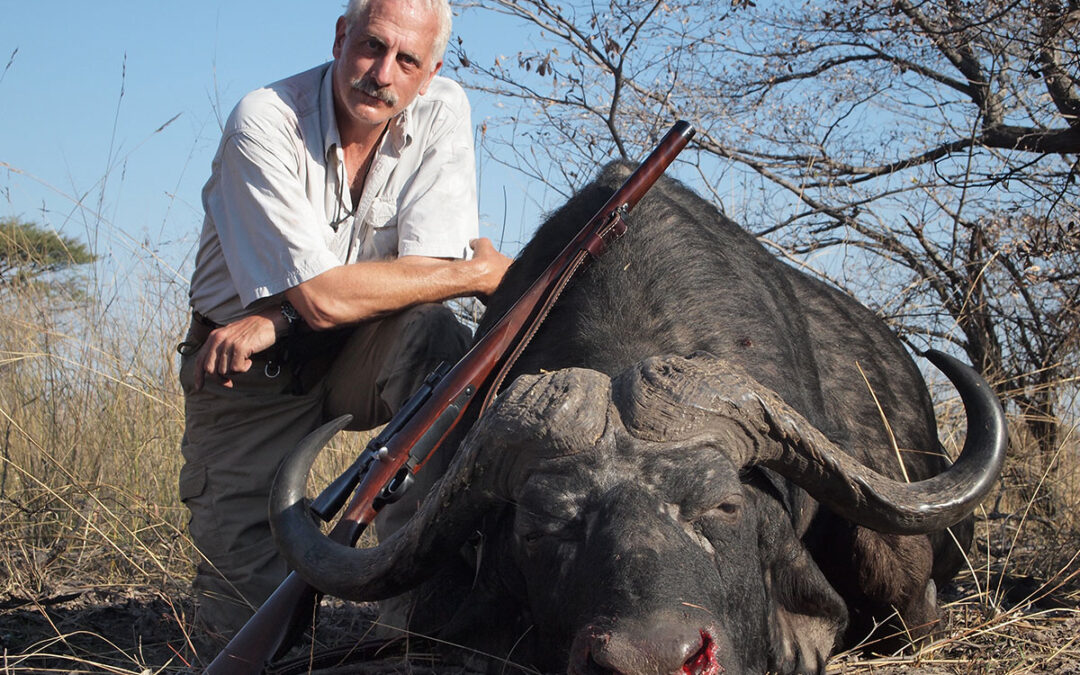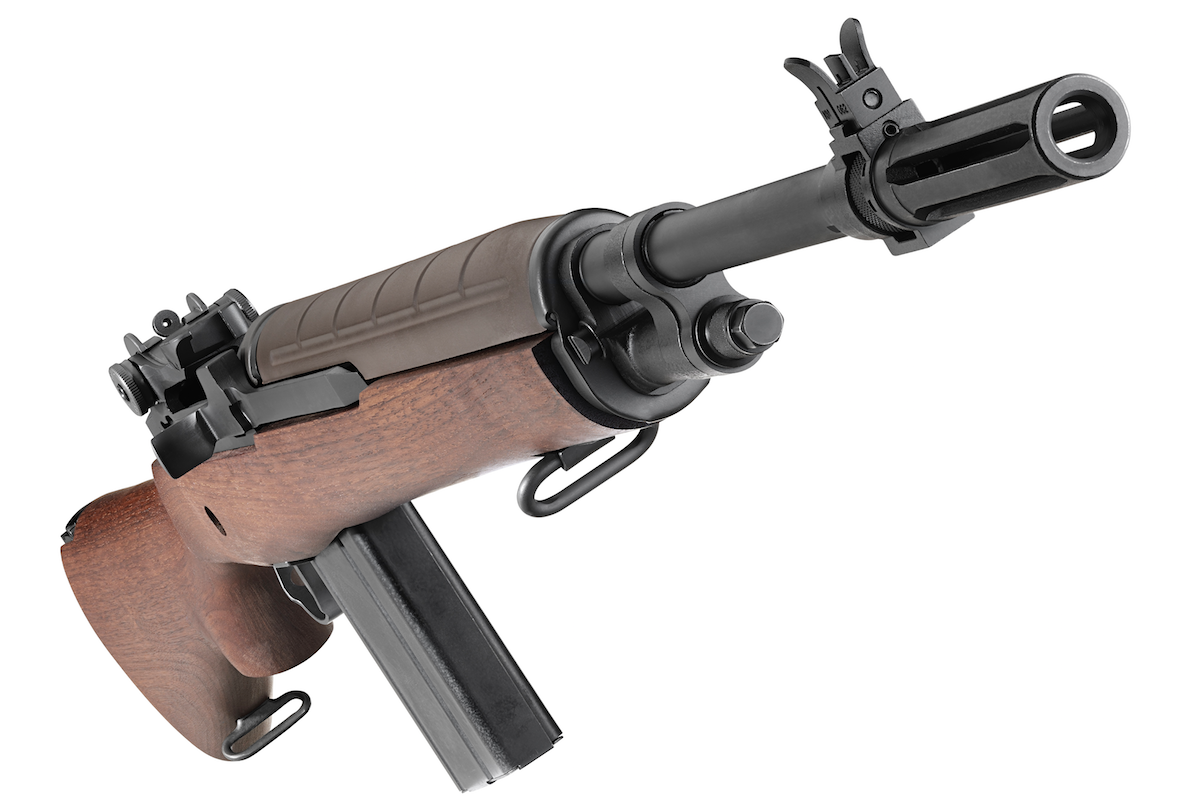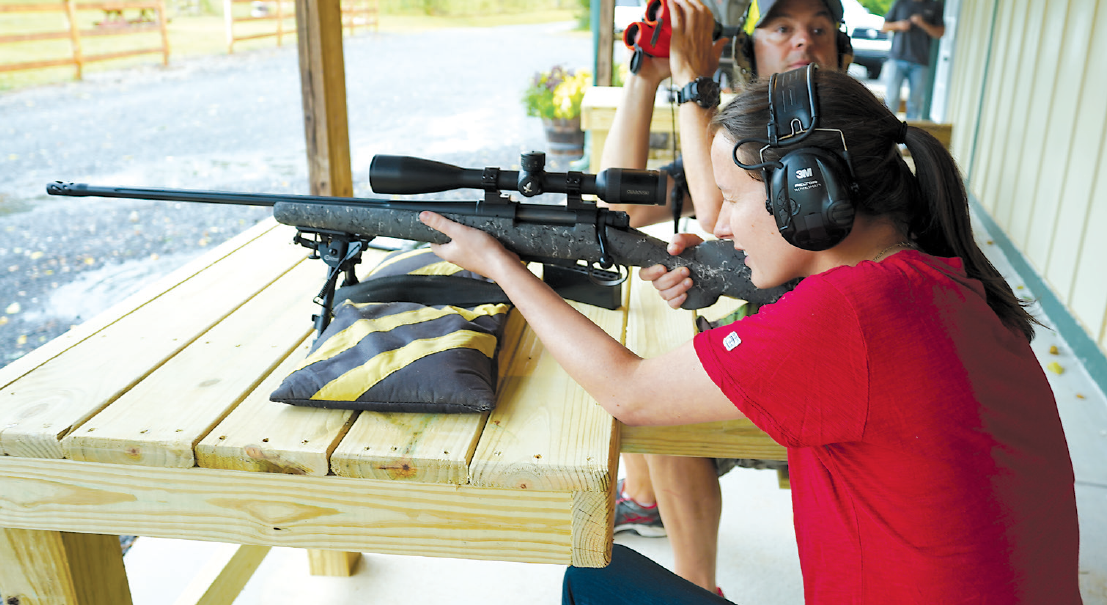James Stejskal details two occasions across the world where he is on the buffalo hunt and just how he went about claiming his prize.
The early morning fog on the river was starting to dissipate as I stood in the waist high grass surveying the terrain ahead. I was hoping there were no other predators in the neighborhood. The Professional Hunter who was guiding me had told me that one of his comrades was badly hurt recently in a leopard attack nearby. Ironically, it was the guest hunter who caused the injury. He tried to shoot the leaping animal and hit the PH in the arm instead. I wasn’t worried about shooting my guide. I was, however, concerned about being eaten by a large cat.
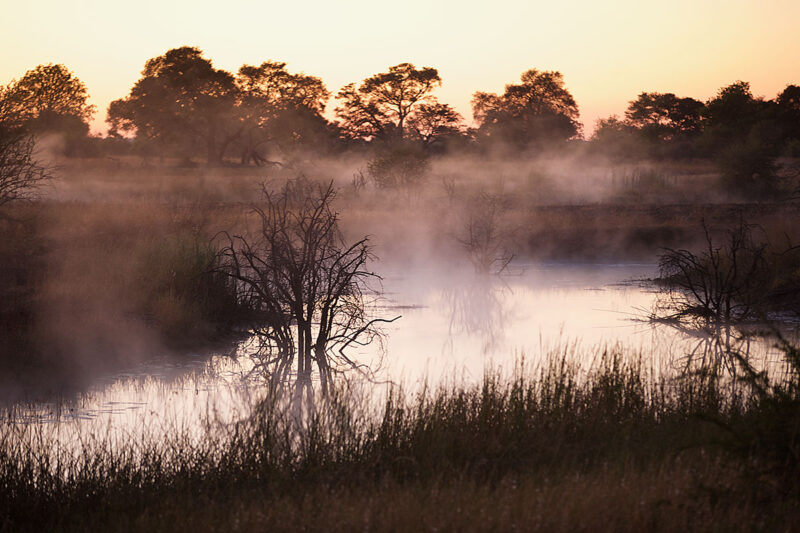
A Kwando River pool steams at dawn.
I was a long way from home, around 8,000 miles to be exact, in Namibia’s Caprivi Strip. But after nearly 20 years of living overseas in different African countries, I felt as home there as anywhere. But I was missing one thing — a Cape buffalo. It had always been on my bucket list — not an elephant nor a lion, certainly not a rhino, but a Cape? Any animal that will hunt his hunter is a worthy opponent.
My previous hunts on the continent were not very impressive — I shot several gazelle and wild boar, but never the beast I wanted. The only time I got a crack at one, I was using a friend’s 375 H&H Mauser. It was well worn and should have been put out to pasture long ago as I was to find out. It had a small crack in the top of the stock just behind the action that no one had noticed. We were on the edge of the Selous Reserve in Tanzania and found a triad of buffalo. I took a shot. When the smoke cleared, the buffalo were gone and I was holding a broken gun. Luckily no one was hurt, except perhaps my friend’s feelings when I handed him the pieces.
That was when I vowed the next hunt would be with my own gun. It was several years later when I learned my wife and I were headed to Namibia that I decided to build a gun to my specifications. When I say, “build” you must understand that I don’t have the skills to assemble anything other than an Ikea bookcase. That said, I do have the ability to find the people who can. And so, my quest began.

The rifle in the “white” before bluing. Note the magnum cross bolt mid-stock in the Susquehanna Stockworks stock.
History and adventure have guided my life. I have always enjoyed the tales of Teddy Roosevelt, Ernest Hemingway and Frederick Selous. At the same time, I was reading about weapons used by the German colonial troops in Africa and one rifle captured my eye — the KAR 88 Cavalry Carbine. The original was not up to taking a buff, but it had style! A short carbine with a full Mannlicher stock — where I was going had a lot of brush. Colorado gunsmith Christian Hofmeister took my Mauser 1908 action to make my vision a reality. He came back to me with a laundry-list of modifications and good ideas that he would incorporate into the new rifle. They all sounded good, so I signed a check and he got started. He advised me to chamber it in 416 Taylor and, with a 1914 CP Goerz 3x “Certar” scope, it was to become my all-round buffalo, kudu, gemsbok rifle.
Craig Libhart of Susquehanna Stockworks built the stock, crafted from a piece of Turkish walnut. The rifle went back and forth between Craig and Christian until it was all together and test fired.
Christian got the finished rifle to me in time to make my airplane for Windhoek, which allowed me to practice shooting big game on the television in my apartment and oil it before I got it ready for the trip. Packing it in a golf case fooled everyone including customs, but after I convinced the officials there was indeed a rifle in the case, I was released into the wilds of the former protectorate of Southwest Africa now known as Namibia.
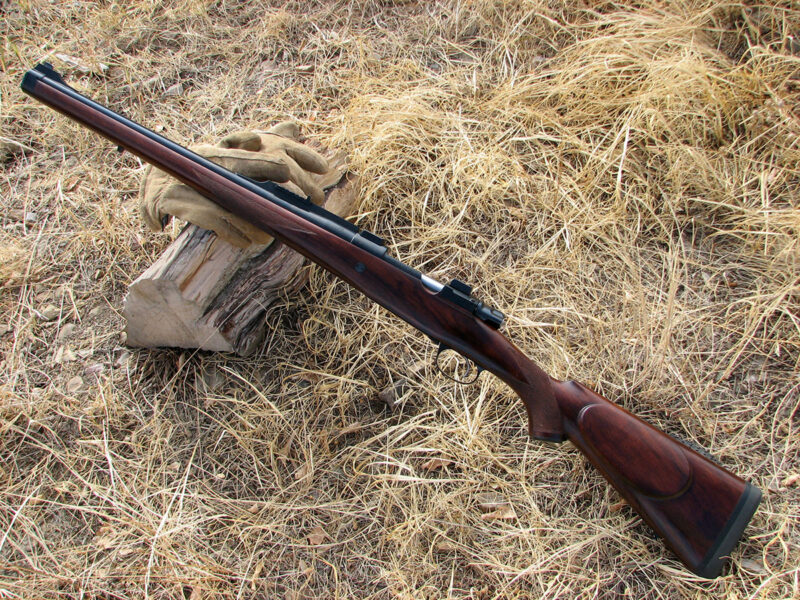
The finished Mauser Mannlicher in 416 Taylor.
Namibia has a mix of private hunting farms as well as open hunting concessions, but Cape buffalo don’t visit the farms. The best place to find them is in the Caprivi, a narrow strip of Namibian territory bordered on three sides by Zambia, Botswana and Angola. It is a flat swampy plain surrounded and crossed by the Chobe, Kwando, Linyanti and the mighty Zambezi rivers. Sparsely populated by humans, the animals are another matter. The Caprivi is hardly a speed bump in the animal migration circuit. Elephant and Cape buffalo move across the borders in huge herds followed by small crews of males ostracized from the main groups. Other animals abound — leopard, hippo, sable, roan and lechwe can be found on the Mukunyati plains and especially in the swamps along the broad rivers of the Caprivi.
My PH was Alan Cilliers who owns a game ranch (great kudu hunting) near Grootfontain in northern Namibia and also hunts in the Bwabwata National Park Conservancy in cooperation with the local community. The fact that Alan is a former Ranger and head Warden of the Etosha National Park speaks volumes about his skills. After setting up the hunt, I finally met him at the airstrip near Katima Mulilo and he whisked me off in a 4×4 Toyota LC76 to his camp situated on the banks of the Kwando River, which would be our home for the next seven days.
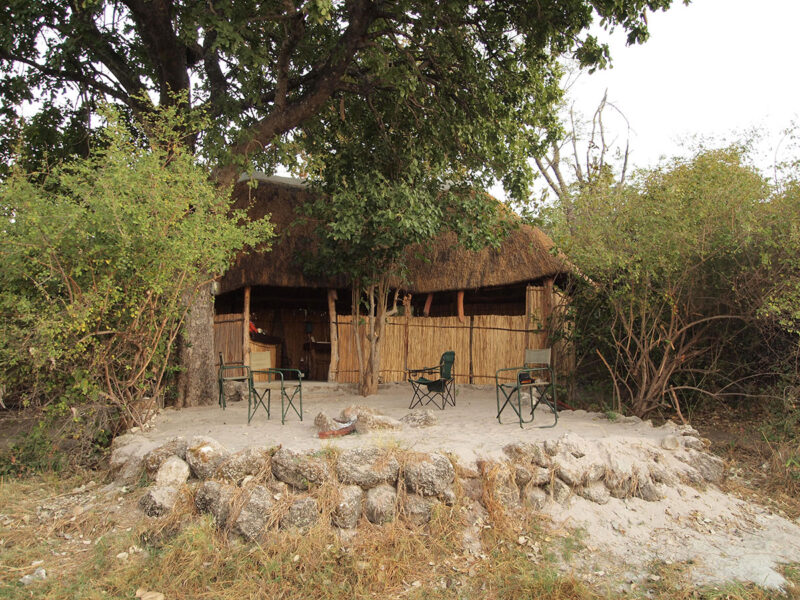
The lapa at Alan Cilliers Kwando River camp is a relaxing place for socializing, meals and camp fires.
To say you are isolated is an understatement. The 2,422 square-mile Babwata is home to a few thousand locals. Alan’s camp is rustic but comfortable and, with his crew of helpers, you won’t lack for anything. The dinner meal on the first night was typical — kudu schnitzel, dutch-oven potato casserole and root vegetables — and it put me in the right frame of mind for hunting.
The next morning after chicory coffee and a hearty breakfast, Alan asked to see my rifle and I proudly offered it for his inspection. He was skeptical at best. “It’s short. Never hunted with this ‘416 Taylor.’ I hope it works.” His words didn’t do much for my confidence. He did accept my qualifications to handle the gun though after I told him of my military background. Thereafter, he filled my ears with tales of the bush war that raged through the area between the South African Defense Force and the Southwest African People’s Organization guerrillas in the 1970s and ’80s. Occasionally we would come across the detritus of war strewn about. Luckily no landmines — I hate landmines.
We began the hunt, pushing eight miles west to search for sign. But it was no joy on the first day. Every time we got close to the isolated males, the ground hornbills or other noisy birds would give us away. The cycle continued as we searched. One of the key things I learned was that when you stalk an animal in the brush, the loudest sound is that of your own footsteps.
We stalked the animals on foot for two to three hours only to hear rolling thunder as the bulls crashed through the brush to escape us.
“The old ones are wary; they know we are hunting them,” Alan told me.
We found one huge herd and decided to see if any big males were about. Stalking to within 150 yards, we scoped the herd. “Nothing, lots of females and youngsters,” Alan said while glassing the animals, dust rising in wispy clouds all around them. We had two unarmed local trackers and a Ranger accompanying us. Alan had his big Weatherby and the Ranger, a South African R5 assault rifle “for our protection.” They were all intently watching the feeding buffalo to their front. Alan clarified that they were probably migrating refugees from Angola, the border wasn’t far.
I happened to look behind us. Facing me straight on about 50 feet away was a solitary elephant, his trunk in the air snuffling our scent. He stood rocking to and fro, contemplating whether he should stomp us all into the ground or move on. I made Alan aware of his presence. He told me to fire a round over his head if he charged and went back to looking at our quarry. He must have known the elephant because it moved on.
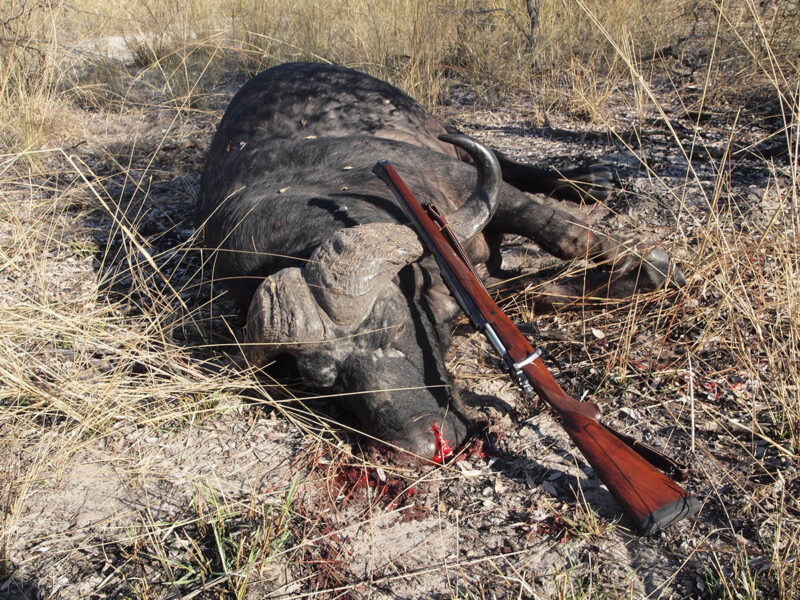
The author’s Cape buffalo taken in the Caprivi Strip with his custom Mauser rifle.
Two more days went by with the same sort of luck. We saw plenty of other game close up, including kudu and more elephant, but not the buff I was looking for. It was day five when luck arrived. We were on our second stalk of the day in the flood plain of the Kwando River, smoke was drifting through the brush, a consequence of slash and burn agriculture outside the park. It made for a surreal sight with a blood red sun overhead, the gray smoke and the golden brush surrounding us.
After about 30 minutes, the trackers told us there were three isolated males ahead and we went into full slow and quiet mode. Alan put me up front when we got close and I was able to see the bulls ahead. One of the trackers offered me a shooting tripod, but it was too much of a hassle to use. I went into my approved Army Marksmanship Unit sitting position, legs crossed, sling around my arm, elbows locked into my knees and stared through the scope. My target was 180 yards away standing side on to me. We were crosswind to them; they hadn’t sensed our approach. I brought him into view and aimed for his heart. When the gun fired, I barely felt the recoil. What I did hear was the slap of the 350-grain A-frame soft point when it hit his hide. He hopped up in the air, turned and ran. Then he did something strange. He stopped.
I took my scope off the rifle expecting the next shots to be shorter range. They were. Alan yelled from behind me, “Don’t shoot them!” as two bulls thundered past us out of the brush. When the dust cleared a moment later, my bull was standing 60 yards away, breathing heavily. I put a second round into his opposite side. This time a 400-grain solid. I heard it thump and watched him run again. We walked carefully toward the crest of the small hill he disappeared behind. Then Alan said very calmly, “There he is, he going to charge.”
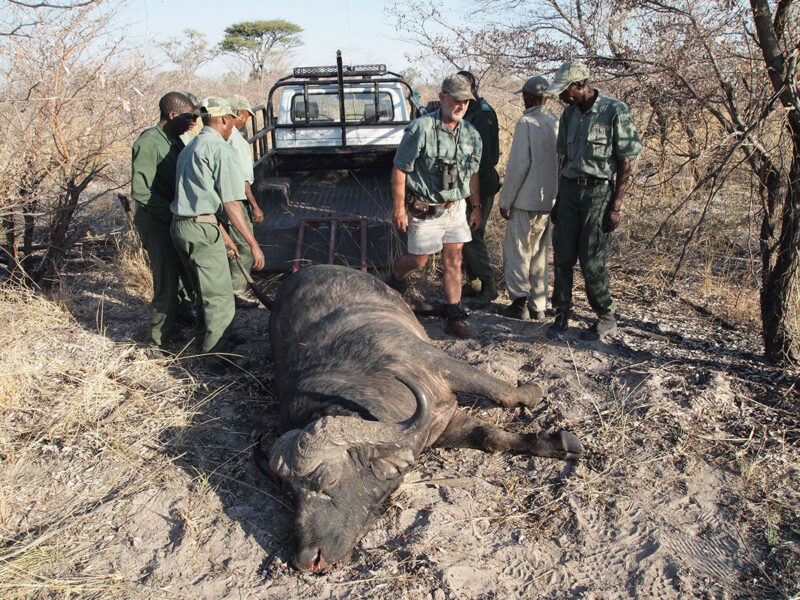
Loading 1,600 pounds of Cape Buffalo onto the Toyota support vehicle.
I saw the buff’s head lowered in the brush 80 yards ahead. I took my last shot at him head on. The third round hit him in the neck directly behind his head. He snorted and finally dropped — really, most sincerely dead. Nevertheless, we approached carefully before we winched him onto the back of the Toyota and, with the rear end almost dragging on the ground, headed back to camp.
His horns were not super big, around 41 inches, but he weighed in around 1,600 pounds. That would be a lot of meat for the locals. The skinner later told Alan he wasn’t sure what kept the buff going because the first two bullets destroyed his heart completely. He was a tough one.
Before I departed, Alan asked me if I wanted to sell my rifle.
It was another year before I returned to the States and my good friend, Pierce Reid, told me he had a new mission for the rifle — a North American bison. Soon we were off to the Midwestern Plains and a long overland drive brought us to the James River Valley in South Dakota where we met up with another outstanding guide, Willie Dvorak, the owner of Jim River Guide Service.
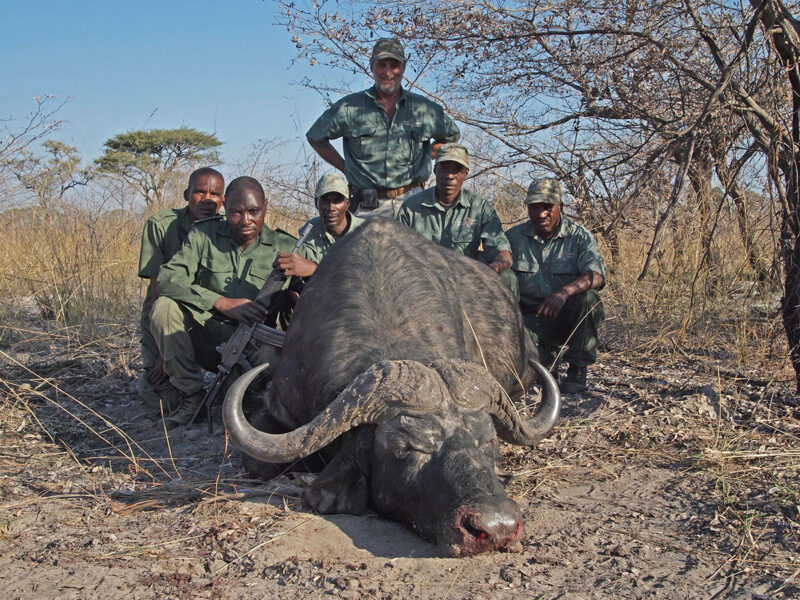
Alan Cilliers and his crew. Note the Game Ranger with an R5 automatic rifle for the group’s protection.
Driving across the nation in a big Dodge Ram brought me close to the people and my country again. Although I was born and raised in Nebraska, it had been a long time and the changes astounded me — huge corn silos and ethanol refineries, wind farms and improved highways. This wasn’t my father’s Midwest.
Soon enough, we found ourselves at Willie’s 5,100 square foot hunting headquarters outside Mellette, which is an excellent base to hunt from. Harkening back to Namibia, he provides first class meals featuring wild game with all the trimmings.
We hit the road the next day, just Willie, Pierce and me, crisscrossing the checkerboard of rural roads that symmetrically pattern the landscape. We didn’t have trackers because we didn’t need them. Willie has a very efficient network of local spotters, farmers and ranchers, who keep him informed on where the bison can be found by novel means — the cellular telephone.
We located a few bison the first day but, once again, not the bison we were looking for. The second day was another matter. Willie got a call that reported two big bulls several miles away. We ditched the vehicle and went overland, through the grass and across the undulating hills of the prairie until we could see the animals about a mile away. Unfortunately, there was no good approach to get closer, so we went around, hoping they hadn’t moved too far. Now we were stalking from west to east with the early morning sun in our eyes. After crossing two lines of barbed wire fence, we approached a ridgeline and went down on our bellies. Pierce and Willie were up front, while I followed with my camera documenting the stalk and hopefully the shot.
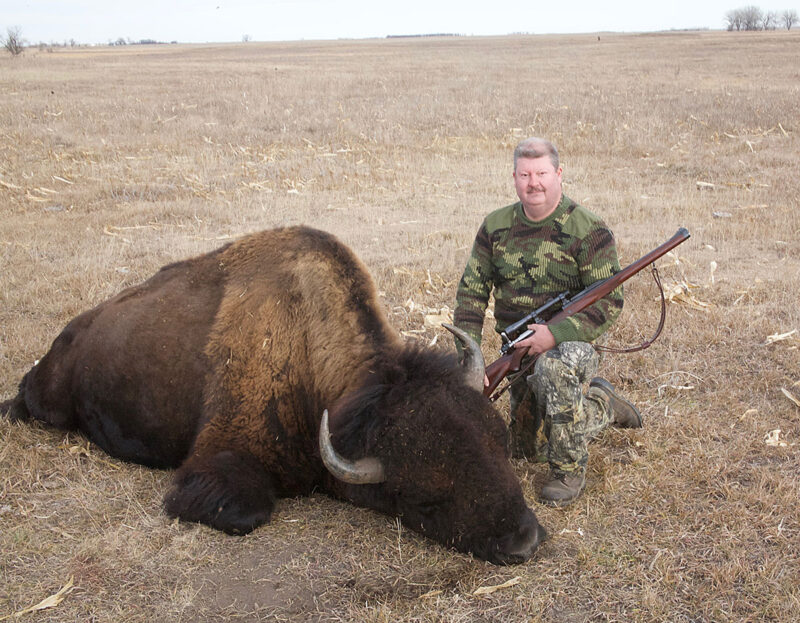
Pierce Reid with the custom rifle and his bison taken in South Dakota about 8,500 miles from where the author used the same rifle to take a Cape buffalo.
We crested the ridge and there they were, two big males calmly grazing on grass. They had no idea we were close; the wind was blowing in our favor and no one had made any loud noises.
Willie quietly advised Pierce on the better target and he crept closer. We were at around 250 yards when Pierce rose up slightly to take his shot. Pierce fired a 350-grain soft point into the bison’s side, he turned, stunned, showing his other side. A second round hit him in the kill zone and he turned to run when a third round hit him from the rear. He dropped. A fourth round ensured the kill. We waited a bit and walked up to the big animal only after we were sure he was dead and that his comrade was verifiably far away and not ill-disposed toward us. Pierce’s bull lay on the grass, steam rising from his hide in the cool November morning. He was a big one and tough as well. Interestingly, we talked about the shot and each of us remembered it differently, only the video told the actual sequence of events.
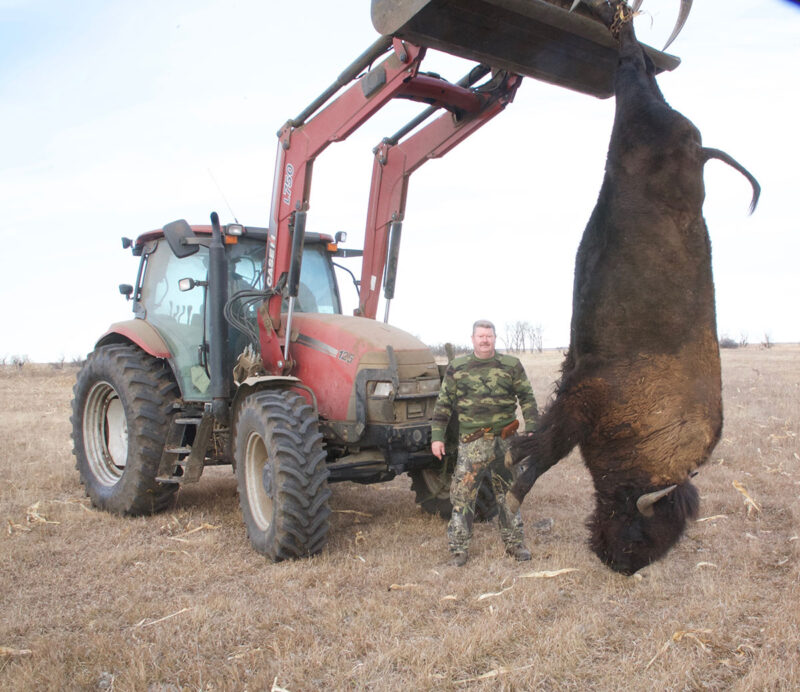
The bison tipped the scales at 1,800 pounds.
A tractor lifted the bull and set him onto Willie’s trailer and we headed back to the headquarters. He weighed in at 1,800 pounds and the meat was quite good (almost as good my Cape buffalo).
Around 8,500 miles separated the two bulls, one near Susuwe in Namibia, the second near Mellette, South Dakota. Pierce said that we had our two “bucket list” buffalo, but asked whether there might not be one more out there waiting for the rifle.
“I haven’t been to Mozambique,” I replied.
 Filmed over a decade in 5 countries, Africa’s Deadliest: World’s Greatest Cape Buffalo Hunts is the ultimate tribute to Africa’s most popular dangerous game. It’s a heart-racing documentary following 11 different notable dangerous game hunters in pursuit of the beast that goes by many names, including ‘Black Death’ and ‘The Widow-maker’. Hear harrowing tales of life and death from professional hunters and others who survived Cape buffalo attacks and marvel the tenacity and toughness of Cape buffalo. Buy Now
Filmed over a decade in 5 countries, Africa’s Deadliest: World’s Greatest Cape Buffalo Hunts is the ultimate tribute to Africa’s most popular dangerous game. It’s a heart-racing documentary following 11 different notable dangerous game hunters in pursuit of the beast that goes by many names, including ‘Black Death’ and ‘The Widow-maker’. Hear harrowing tales of life and death from professional hunters and others who survived Cape buffalo attacks and marvel the tenacity and toughness of Cape buffalo. Buy Now
